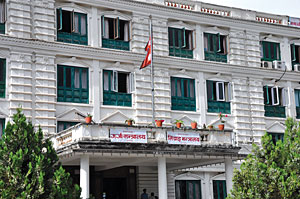 BIKRAM RAI |
Government officials have called for the integration of ministries that were split up during Madhav Nepal's tenure to accommodate more ministers. They have suggested the government do so as the new cabinet is being formed.
Former PM Nepal split the Ministry of Water Resources and the Ministry of Science, Technology and Environment, increasing the number of ministries to 26. A hundred new posts, including two secretaries and five joint secretaries, were added for the new portfolios, increasing the administrative costs of a government already short of funds.
Officials complain that the division of the water resources ministry created difficulties when it came to negotiating with India on hydropower, irrigation and flooding. There are more than a dozen committees responsible for these issues and splitting the ministry created confusion as to work allocation. "There is a real confusion among officials as to who should attend the bi-national meetings now. The energy secretary participates in the secretary level meetings and the joint secretary of irrigation attends the technical committee meetings now," an official has said. The splitting of the ministry into energy and irrigation contradicts the country's commitment to an integrated approach to water resources management.
The division of the Science and Technology Ministry has also led to confusion. Now that the Department of Hydrology and Meteorology and the Alternative Energy Promotion Centre have been moved to the Environment Ministry, the Science and Technology Ministry has found itself without work. Officials allege that the ministry was split by Madhav Nepal only to please the Nepal Communist Party (Sanyukta), which demanded a portfolio like the Nepal Janashakti Party (which had less MPs than it in parliament). Janashakti's Indra Prasad Dhungel was named Minister of Science and Technology, and Thakur Sharma of Sanyukta was named Minister of Environment, subsequently.
READ ALSO:
Childless poverty
Golden wheat
ATMs for IC


